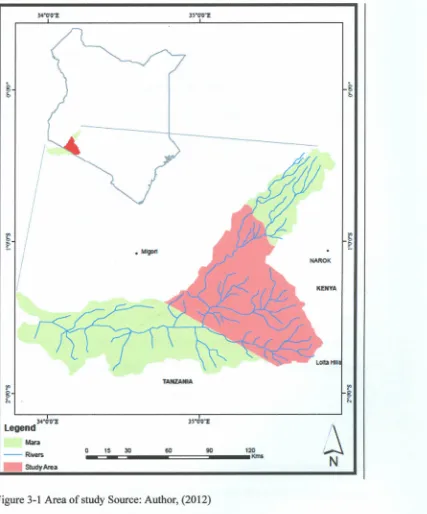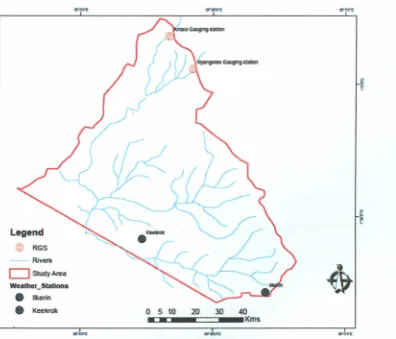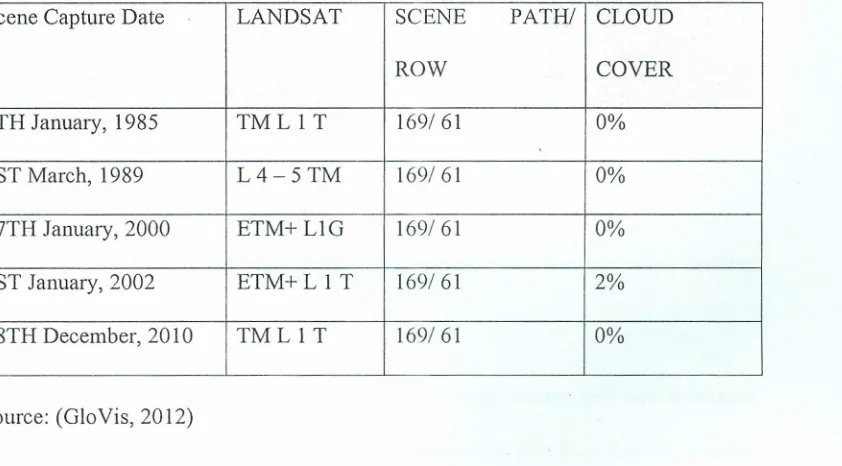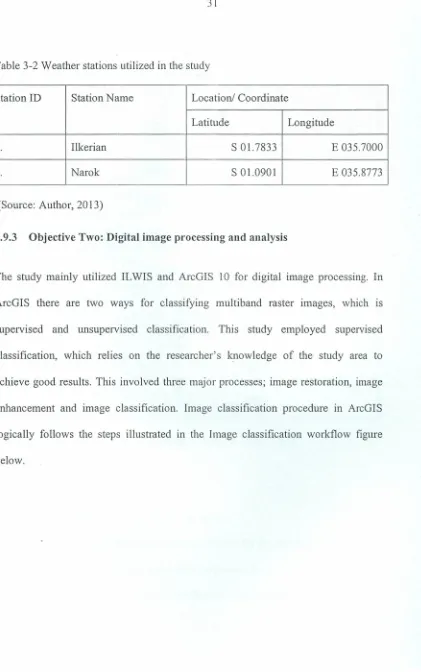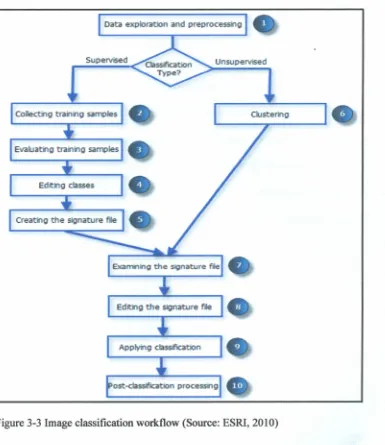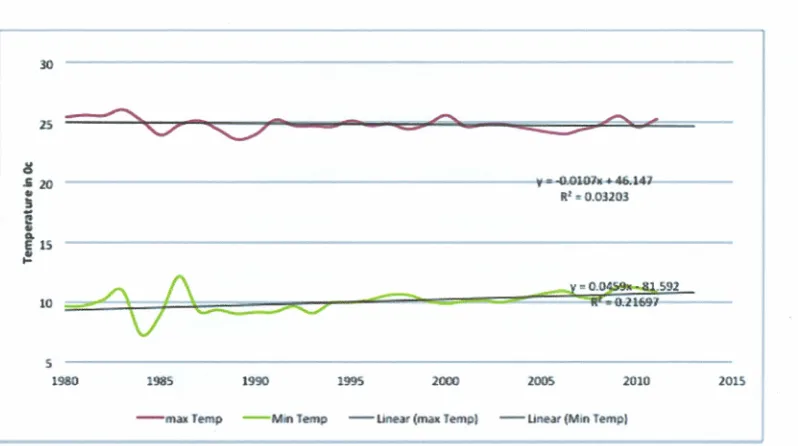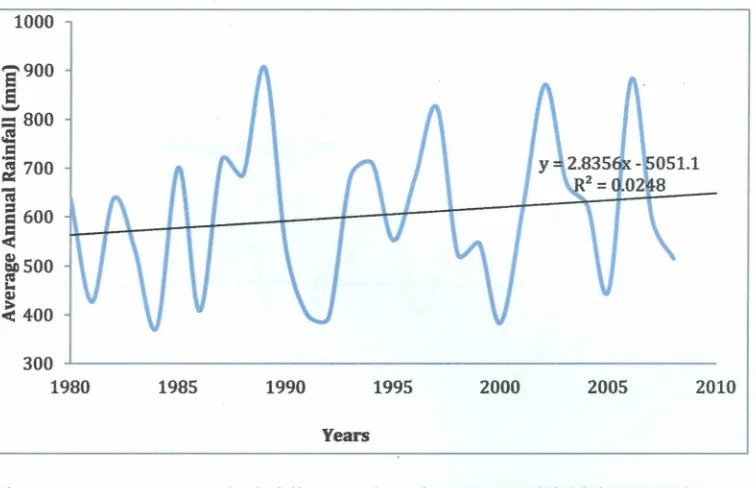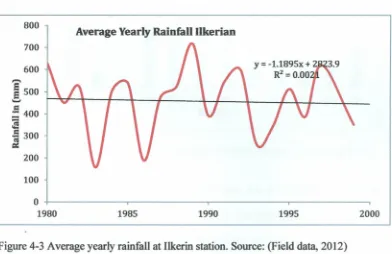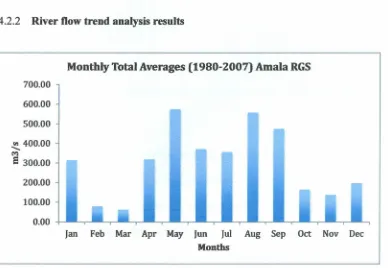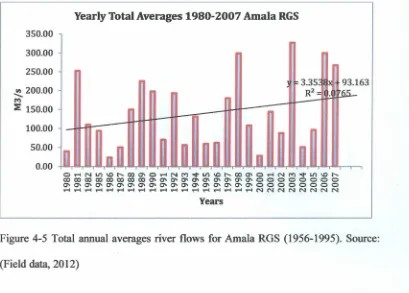ASSESSMENT OF VULNERABILITY OF WATER RESOURCES
TO CLIMATE VARIABILITY IN MARA RIVER BASIN , KENYA
~~.:-\4c i .' 1 '.
BY ~ '(.) '1-r--:. -" '\ r ' -," _. - ¥ REVEL KAMAV W AITHAKA (BSc ENV, KU)
(156/l2145/09)
A Thesis Submitted in Fulfilment of the Requirements for the Degree of Master of Science (Integrated Watershed Management) of Kenyatta University
DECLARATION
This thesis is my original work and has not been presented for a degree or any other award in any other University.
Signahlfe~~
e:Kamauw:haka·
Date {CO(
Ls/'4
Department of Geography
We confirm that the candidate under our supervision carried out the work reported in this thesis
Signature~HHwHwHH~~DateJ~Jl.l~Qlyw
Prof. Joy A. ObandoDepartment of Geography
Signature
....
H~O ~~;is~1:~:···Date...Il(~1~.L't
..
III
DEDICATION
ACKNOWLEDGEMENTS
Finally, the culmination of a journey that started with a single step and gradually developed into one mighty task. My joy and sense of fulfilment would not be complete without making mention of everyone who offered help and support, in one way or another, during the entire period of this master's study. The brevity of this acknowledgement does not in any way downplay the support I have received from anyone mentioned, or not mentioned, herein. Firstly, I am sincerely grateful to Mr and Mrs Lawrence Waithaka and East Africa office -Global Water for Sustainability (GLOWS) for their financial support in form of tuition and scholarship. to undertake this study. I thank my workmates Mr. Aron Kecha and Mr. Griffins Ochieng who gave me time to concentrate on my studies at the expense of work the office.
v
East Africa Global Water for Sustainability (GLOWS) coordinator for the efforts you made tomake sure I got the funds.
TABLE OF CONTENTS
DeeIar ati0n --- ii
De die a ti0n --- iii
A ckn0 WIed gem en ts --- iv
Tab Ie of Con ten ts --- vi
List of figures --- ..--- x
List of tables --- xi i
Acr 0n yms and Ab b r evia ti0ns --- xiii
A b str act --- xv CHAPTER ONE: INTRODUCTION --- 1
1.1 Background of the study 1
1.2 Statement of the problem 3
1.3 Justification of the study 3
1.4 Research questions .4
1.5 Objectives of the study .4
1.5.1 Main objective .4
1.5.2 Specific objectives 5
1.6 Significance of the study 5
l.7 Scope and limitations of the study : 5
1.8 Operational definition of terms 6
CHAPTER TWO: LITERATURE REVIEW --- 8
2.1 Introduction 8
VII
2.3 Impact of climate change and variability on water resources 9
2.4 Linking climate change and water resources 9
r:
2.5 Assessment of vulnerability and climate variability 10
2.6 Climate Variability analysis by NDVI 13
2.7 Conceptual framework 16
CHAPTER THREE: MATERIALS AND METHODS---20
3.1 Introduction 20
3.2 The study area 20
3.3 Climate of the study area 22
3.4 Socio-economic Characteristics 22
3.5 Sampling Techniques 22
3.6 Data collection and quality control 24
3.7 Data type and sets 24
3.7.1 Objective One: Hydro-meteorological data 24 3.7.2 Objective Two: Satellite images and Remote Sensing Data 26
3.7.3 Objective Three: Socio-economic data 27
3.8 Data analysis methods 28
3.8.1 Objective One: Hydro-meteorological 28
3.9.3 Objective Two: Digital image processing and analysis 31 3.8.2 Objective Three: Socio-economic data analysis 36 CHAPTER FOUR: RESULTS AND DISCUSSION ---37
4.1 Introduction 37
4.2.1 Climatic trend analysis 37 4.2.2 River flow trend analysis results 41 4.3 Objective Two: Satelite imagery analysis results .45 4.3.1 Assessment of Land use/land use change .45 4.3.2 Assessment of Normalized Difference Vegetation Index (NDVI)49 4.3.3 Mara River Basin water bodies trend from 1985 to 2010 54 4.4.1 Influence of climate variability on the socio-economic livelihoods55
4.5 Discussion of Results 77
4.5.1 Objective One: Hydro-climatic trends in the Mara river basin 77 4.5.2 Objective Two: Assessment of land use/ land use changes in the Mara
river basin 91
4.5.3 Objective Three: Assessment of the influence of climate variability on the socio-economic livelihoods in the Mara river basin 97
CHAPTER FIVE: SUMMARY OF FINDINGS, CONCLUSIONS AND
RE COMMEND A TI 0N S--- 103
5.1 Introduction 103
5.2 Summary offindings l03
5.2.1 Objective One: To examine the hydro-climatic trends in the Mara River basin 103
5.2.2 Objective Two: To examine the hydro-climatic trends interactions with land use/land use change that influence water resources vulnerability ... 106 5.2.3 Objective Three: To assess the influence of climate variability on the socio-economic livelihoods in the Mara river basin 107
IX
5.3.1 Objective One: To examine the hydro-climatic trends in the Mara River basin 108
5.3.2 Objective Two: To examine the hydro-climatic trends interactions with land use/land use change that influence water resources vulnerability ... 110 5.3.3 Objective Three: To assess the influence of climate variability on the socio-economic livelihoods in the Mara river basin 112
5.4 Recommendations 113
5.4.1 Objective one: To examine the hydro-climatic trends in the Mara River basin 113
5.4.2 Objective two: To examine the hydro-climatic trends interactions with land use/land use change that influence water resources vulnerability ... 114
5.4.3 Objective three: To assess the influence of climate variability on the socio-economic livelihoods in the Mara river basin 114
LIST OF FIGURES
Figure: 2-1 Conceptual framework for assessing climate vulnerability. Adopted and
modified from (F"ussel &Minnen, 2002) 18
Figure 3-1 Area of study Source: Author, (2012) 21
Figure 3-2 River gauges and weather stations in the area of study. Source: Author,
(2013) 25
Figure 3-3 Image classification workflow (Source: ESRI, 2010) 32 Figure 3-4 Area of study in the context of the Landsat scenes used (Source: Glovis,
2012; WRI, 2008) 34
Figure 4-1: Maximum and Minimum temperature at Narok Station. Source: (Field
Data, 2013) 38
Figure 4-2 Average annual rainfall at Narok station. Source: (Field data, 2012)39 Figure 4-3 Average yearly rainfall at Ilkerin station. Source: (Field data, 2012)40 Figure 4-4 Monthly total average Amala RGS 1956-1995. Source: (Field data, 2012)
... 41 Figure 4-5 Total annual averages river flows for Amala RGS (1956-1995). Source:
(Field data, 2012) 42
Figure 4-6 Monthly average totals Nyangores RGS (1964-1999). Source: (Field data,
2012) 43
Figure 4-7 Total averegae flows Nyangores RGS. (Source: Field data, 2012) 44 Figure 4-8: Land use thematic maps from 1985-2010. (Source, Author 2013)46
Figure 4-9: Normalised Difference Vegetation Index (NDVI) Images (1985-2010).
(Source: Field data, 2013) 50
Figure 4-10: Normalized Difference Water Index (NDWI) images (1985-2010).
Xl
Figure 4-11: Summarised surface water trends from 1985-2010. Source (Field data,
2013) 55
Figure 4-12: Size ofland of the respondents. Source: (Field survey, 2013) 61 Figure 4-13: Type of crops grown (Source: Field survey, 2013) 63 Figure 4-14: Food deficiency months. (Source: Field survey, 2013) 64 Figure 4-15 Challenges of livestock lceeping. (Source: Field survey, 2013) 66 Figure 4-16: Causes of drought (Source: Field survey, 2013) 67 Figure 4-17: Frequency of the droughts (Source: Field survey, 2013) 68 Figure 4-18: Sources of water in the study area. (Source: Field survey, 2013)69 Figure 4-19: Challenges in water accessibility. (Source: Field survey, 2013) .71 Figure 4-20: Solutions to water accessibility and availability. (Source: Field survey,
2013) 72
Figure 4-21: Observed climate changes. (Source: Field survey, 2013) 73 Figure 4-22: Major effects of climate change on the households. (Source: (Field
survey, 2013) 74
LIST OF TABLES
Table 3-1: Satellite images used in the study 26
Table 3-2 Weather stations utilized in the study 30
Table 4-1: Summary of Land use thematic map .47
Table 4-2: Summarised household characterization 57
Table 4-3: Land utilization 61
Table 4-4: Reasons for food deficiency 64
Table 4-5: Type of livestock 65
Table 4-6: Types of water uses 69
Table 4-7: Distance travelled 70
Table 4-8: Types of sources of water 70
Table 4-9: Adherence and effectiveness ofEWS information 77 Table 4-10: Temperature and rainfall scenarios and potential effects on water
Xlll
ACRONYMS AND ABBREVIATIONS
ALRMP Arid Lands Resource Management Programme AOI Area of Interest
ASALs Arid and Semi-Arid Lands ENSO EI Nino Southern Oscillations
ESARO East and Southern Africa Regional Office ETM Enhanced Thematic Mapper
EWS Early Warning systems GCM Global Circulation Models
GIS Geographical Information Systems GPS Global Positioning Systems
IIRR International Institute for Rural Reconstruction IPCC Intergovernmental Panel on Climate Change
IR Infra-Red
KMD Kenya Meteorological Department LANDSAT Land Satellite
LULC Land Use Land Cover LVB Lake Victoria Basin
MDGs Millennium Development Goals
MK Mann Kendall
MMNR Maasai Mara National Reserve
MWI
NDVI
NDWI
NIR
RGS
SOE
SSA
TAR
TM
UNEP
UNEP
USGS
WRMA
WFP
WWF
Ministry of Water and Irrigation
Normalized Difference Vegetation Index
Normalised Difference Water Index
Near Infra-Red
River Gauging Stations
State of Environment
Sub Saharan Africa
Third Assessment Report
Thematic Mapper
United Nations Environmental Program
United Nations Environmental Programme
United States Geological Survey
Water Resources Management Authority
World Food Prograrnme
xv
ABSTRACT
Different African regions have been recognized to have climates that are among the
most variable in the world on intra-seasonal to decadal timescales. The continent is
characterized by a highly variable climate (Hulme et al.. 2001) climate change
models suggest that, in general terms, the climate of Africa will become more
variable. Although the exact nature of the changes is not known and remains debatable, there is general consensus that extreme events willmore frequent and may
get worse (Elasha, 2006). The (IPCC, 2001) report cites changes in some extreme
climate phenomena indicating that extreme events, including floods and droughts,
are becoming increasingly frequent and severe. According to (IPCC, 2001), impacts
of climate change in Africa are likely to be more severe on the continent's water
resources and food security, precipitation and insulation, length of growing seasons, water availability, carbon uptake, incidences of extreme weather events, changes in
flood risks, drought, distribution and prevalence of human diseases and plant pests. It is probable that these increased frequency of disasters results from a combination of
climatic variability, socio-economic and demographic changes.
The variability in climate particularly the changes in temperature, precipitation and
sea levels are expected to impact on availability of freshwater. This is of particular concern to Africa, where around 300 million people have no access to potable water
2
Wit & Jacek, 2006). Due to the inter-annual variability of rainfall, people are
becoming reliant on other sources like groundwater and water harvesting as their
source of freshwater. Studies by (Stutcliffe & Knott, 1987: Groove, 1996; Conway,
2002) demonstrate high levels of inter-annual variability in many river basins of
Africa. This variability is experienced mostly in dry areas (less than 800mrn of
rainfall per annum).
Global wanmng is rendering the climates of some regions dryer and all more
variable and unpredictable (Parry, 1992). For example, the arid and semi-arid of
sub-Saharan Africa (SSA) are characterizecl by limited water supply, low and highly
variable rainfall, and recurrent droughts. High temperatures and intense precipitation,
associated with achanging climate, causes increased water loss through evaporation
and run off, respectively (IRR, 2002). The rainfall is bimodal and characterised by
spatial-temporal uncertainty. Rainfall seasonality affects forage availability, livestock
production and ultimately the livelihoods of pastoralists. The 1998 El Nino
phenomenon produced an estimated five-fold increase in rainfall (G1alvin et al., 2001) the phenomenon fell between some of the worst drought years in 1997 and
1999 according to (WFP, 2000). Such extremes of climate variability make
funclamental changes to ecosystem structure and function. These in turn affect human
land-use, wildlife and livelihoods and have the potential to make these populations
more vulnerable. The Mara River, rises on the Mau escarpment in Kenya an
important water tower, is one of the most ecologically important trans-boundary river
sustainability of the nver basin, with potentially detrimental impacts on the ecosystem as a whole. This study therefore attempts to assess the vulnerability of the water resources within the basin caused by climate variability.
1.2 Statement of the problem
Climate adaptation research, while it has provided vital information in understanding climate change and variability, it has had its focus on climate change scenarios
emphasizing more on technical and infrastructural adaptive strategies to climate variability. This approach limitedly accounts for varying climates in terms of rainfall amounts, duration and temperatures especially at local levels, where adaptive and coping strategies are needed most. The Mara river basin is undergoing ecological changes that are associated with deforestation on the Mau catchment, and land tenure changes due to expansion of cash crops and settlements, among other factors. The above factors coupled with potential climatic variability, already witnessed in the East African region, have negatively impacted on water resources within the Mara river basin. This study therefore seeks to add information and knowledge on the status of the water resources and the impact of climate variability to ensure timely detection and predication of any impacts.
1.3 Justification of the study
Water resources and livelihoods particularly in Sub-Saharan Africa are highly vulnerable to year-year climate variability. To resource-limited households who
4
water scarcity remains a challenge. It is anticipated that assessment of vulnerability to climate variability would go along way to capture the multiple factors that impact on people's livelihoods especially to water sources. This study identified the Mara river basin in Kenya, a semi arid area susceptible to rainfall variability, the main social economic activity being pastoralism, tourism and both small and large-scale mechanized farming. The area depends on Mara River, swamps and seasonal rivers namely Talek, Engare Ngobit and Sand River. Given the effect of climate variability on water resource. This assessment offers a wider scope in developing strategies for efficient water resource management in thebasin, as there isneed to adapt to changes in the volume, timing and quality of water (Wigley, 2005)
1.4 Research questions
1. How are the hydro-climatic trends in the Mara river basin?
11. How does the trends interact with land use/land use change to influence vulnerability of water resources
111. How do the trends influence vulnerability of socio-economic livelihoods?
1.5 Objectives of the study
1.5.1 Main objective
1.5.2 Specific objectives
i) To examine the hydro-climatic trends in the Mara river basin
ii) To examine the hydro-climatic trends interactions with land use/land use
change that influence water resources vulnerability.
iii) To assess the influence of climate variability on the socio-economic
livelihoods in the Mara river basin.
1.6 Significance of the study
Climate variability and water resources management are significant global issues
with regional, national and local impacts. This is evident in Kenya where an
increasingly variable climate has resulted to prolonged drought and widespread
flooding. This study assesses the risks to water resources due to climate variability
and change. This is significant in policymaking and implementation especially in
water resources management, planning and design of infrastructure. It is widely
recognized that improved incorporation of current trend of climate variability would
make future adaptation easier. Water resources management is clearly linked to other
policies; hence the study aligns adaption measures across multiple water dependant
sectors.
1.7 Scope and limitations of the study
The study is based in the Mara river basin in Kenya, the middle catchment of the
6
vulnerability of water resources to climate variability within the sub-catchment. It
utilises datasets such as river flow data, temperature, and rainfall and satellite
images. The study utilizes river flow gauging stations namely Nyangores and Amala,
two weather stations namely Narok (1980-2010), and Ilkerin Integral Development
(1980-1999). Assessment of vulnerability relies heavily on data and this was the
biggest limitation scanty data on rainfall, temperature and river flow data, due to lack
of temperature data the study utili sed data of adjacent weather stations with similar
altitude e, Other limitations encountered in the field were language barrier and false
responses from respondents. However, efforts were put in place to minimise their
impact on the outcome of the study.
1.8 Operational definition of terms
Adaptation: adjustments in natural or human systems in response to actual or
expected climatic stimuli or their effects, which moderates harm or exploits
beneficial opportunities.
Climate change: Changes in the mean climate on a global scale
Climate variability: Is defined as inter-seasonal and/or inter-annual variation of the
climate within a specified geographic location.
Livelihood: The capabilities, assets and activities required for means of living.
Sensitivity: The degree to which a system IS affected, either adversely or
beneficially, by climate-related stimuli.
8
CHAPTER TWO: LITERATURE REVIEW
2.1 Introduction
This chapter reviews empirical works done by other scholars in the field of climate
variability and its effect on water resources and management. The chapter deals with
role of climate variability and the link to water resources, and inherently the
assessment of the future vulnerability and conceptual framework. It reviews studies
done specific to the basin and identifies gaps that this study attempts to fill.
2.2 Overview of climate change vulnerability
A decade of research on climate change vulnerability shows that inevitably it is the
poor and the most vulnerable who suffer the impacts of changing environmental
conditions (Adger, 2000; Downing, 2003), Vulnerability is both spatial and temporal
variable; manifested in local economic, social and cultural characteristics, as well as
the local physical conditions. The World Bank (2002) states that the linkages of
climate variability impacts to water resources are dynamic, often inter-connected,
and context-specific reflecting geographic location; economic, social, and cultural
characteristics; prioritization and concerns of individuals, households, and social
groups; as well as institutional and political constraints. This means that the
assessment of vulnerability must be made at the appropriate spatial scale for example
at sub-basin in order for it to be useful for defining the appropriate adaptation
2.3 Impact of climate change and variability on water resources
Rainfall and water resources in Africa display high levels of variability across a range of spatial and temporal scales with important consequences for the management of variability and risk in water resource systems. Studies by (Stutcliffe & Knott, 1987; Groove, 1996; Conway, 2002) demonstrate high levels of inter-annual variability in many river basins of Africa. Detailed studies of smaller size river basins in East Africa highlight changes in daily flow characteristics; for example, in Tanzania, (Valimba et al., 2008) identified the effects of human activities on the land surface and their influence on flow regimes in the Mara River Basin. He found out that the main driver of variability in river flows was of course rainfall, particularly at the scale of large river basins. Nevertheless, in spite of the large influence of rainfall fluctuations on river flow variability the response may be influenced by other factors such as changes in land cover or land use, abstraction,
hydrological characteristics (Ribot et al., 1996) argues. The actual hydrological conditions will also mediate the effects of rainfall variability; for example, lake and wetland systems may smooth and delay runoff responses according to (Adger, 2000) and semi-arid river basins with low runoff coefficients often exhibit high sensitivity to rainfall fluctuations (Nemec &Schaake, 1982).
2.4 Linking climate change and water resources
10
in the icecaps of Antarctica and Greenland leaving the remaining 30% (equal to only
0.7% of total water resources worldwide) available for consumption. From this
remaining 0.7%, roughly 87% is allocated to agricultural purposes (IPCC, 2007).
Since the Third Assessment Report (TAR) by the IPCC, there have been many
studies on trends in river flows during the 20th century at scales ranging from
catchment to global. Some of these studies have detected significant trends in some
indicators of river flow, and some have demonstrated statistically significant links
with trends in temperature or precipitation. Groundwater flow in shallow aquifers is
affected by climate variability and change through recharge processes as studied by
(Chen et al., 2002) as well as by human interventions in many locations (Petheram et
al., 2001). A variety of climatic and non-climatic processes influence flood characteristics, resulting in river floods. Floods depend on precipitation intensity,
volume, timing, antecedent conditions of rivers and their drainage basins amongst others. Kron & Berz (2007) however observed that the increase in precipitation
intensity and other observed climate changes often trigger floods, and that climate
change might already have had an impact on the intensity and frequency of floods.
2.5 Assessment of vulnerability and climate variability
The literature on vulnerability and variability assessment is very large and increasing rapidly. Brooks (2004) point out that even in the (IPCC, 2001) there is inconsistent use of the term vulnerability assessment. According to (O'Brien et al., 2002)
biophysical vulnerability, or the sensitivity of the natural environment to an exposure to a hazard; and social vulnerability, or the sensitivity of the human environment to the exposure.
Mutal et al. (2002) identified vulnerability indicators of the water resources to climate variability; they found out both natural (temperature, rainfall, evapo-transpiration) and artificial factors associated with human activities like settlements, land use/ cover change, and population increase. For the purpose of this study, the research focused on rainfall and temperature as the indicators of study due to their spatial and temporal variability. Artificial factors were used in mapping as they enhance or exacerbate the vulnerability. Kundzewicz et al. (2007) looked at impact of climate change on freshwater resources and how it has influenced water management and achievement of Millennium Development Goals (MDGs). They found out that Arid and Semi Arid Lands (ASALs) areas already experiencing water scarcity would be the most vulnerable due to decreasing water resources resulting from the decline on surface and subsurface flows. They recommend shift in water management to go beyond infrastructure development to address the problem and include forecasts, models and climate variability science in developing the water
management policies.
12
national representation does not provide any indication of how risks are distributed
across a country or region and they recommend assessment of vulnerability be
considered beyond the national scale. They point out that the assessment be done at
appropriate spatial scale in order to be useful for defining adaptation and mitigation
measures. It is against this recommendation that this study seeks to assess the
vulnerability at a local scale.
A hydro-meteorological data analysis by (Melesse et al., 2008) for the Mara river
basin showed an annual decline of 14% of rainfall in the Kaptunga forest, the river
flows of Amala and Nyangores had different hydrologic responses with Amala
having a low dry flow and a high wet flow unlike that of the Nyangores. He
concludes that high wet season and low dry season flows can be attributed to less
vegetation cover leading to low recharge in the headwaters and also flashy runoff due
to less infiltration associated with less vegetation cover but recommends further
studies on the actual cause of the flow reduction in the basin. Further research by
(Melesse et al., 2008) to model the impact of Land-cover and rainfall regime
scenarios on the flow of Mara River; used the Soil and Water Assessment Tool
(SW AT) Model to consider different input scenarios of land-cover and precipitation
pattern to estimate the changes in the hydrologic flow of the basin, The analysis
showed that a 20% reduction in rainfall translates to a46% flow reduction annually,
the model predicts a rainfall decline by 20% for the period of 2010-2030. But
according to (Ringus et al., 1996) there is contradiction with this study. His
warmer by the year 2050; annual rainfall will increase by 20% within the same period especially in the highlands while potential evapotranspiration (PET) is expected to increase in Africa region.
2.6 Climate Variability analysis by NDVI
Maps and time series of Normalized Difference Vegetation Index (NDVI) help to get insight in the changes that occur in the fractional vegetation cover pattern at a global scale. The degradation and intensification is not solely dependent on climate change. Many factors play an important role in the variation of vegetation cover; like deforestation for wood production and agricultural cropping cycles and due to forest fires and disasters. Besides this, there is anatural variation of rainfall, solar radiation and temperature depending on the seasons. Other variations occur in shorter and longer cycles, which can have decadal and multi-decadal periods. Labat (2008) analysed the long-term annual fluctuations of large river discharges by means of wavelet transforms. He concluded that the investigated rivers show interannual, 15-20-year and 28-30-year variability. Since river flow reflects rainfall and rainfall induces green vegetation, these time scales should be found in the variations of the vegetation cover as well. This can be studied by means of a NDVI time series to quantify the actual fractional vegetation cover changes caused by climate change and human activities
14
relations between NDVI and measured vegetation need to be established. NDVI is
used to study changes in the fractional ground cover. Changes in the vegetation cover
are often related to variations in seasonal weather conditions and the moisture
availability in the subsoil. Therefore relation between phonological behaviour,
climate and land use exists (Labat, 2008)
The phenology of vegetation IS influenced by temperature, moisture and soil
conditions (Andreas et al., 1984). Vegetation vanes within biannual, annual and
inter-annual periods. Variations in the vegetation cover are strongly related to the
amount and distribution of rainfall (Anyamba & Eastman, 1996). The correlation
between precipitation and NDVI was demonstrated by (Gray & Tapley, 1985;
Greegor & Norwine, 1986; Justice et al., 1986; Nicholoson et al., 1990; Tucker &
Nicholson, 1999; Eklundh & Olsson, 2003 and Martiny et al., 2006). A near linear
relation between the NDVI growing season and the rainfall was found for East Africa
and the Sahara by (Justice et al., 1986) and (Tucker & Nicholson, 1999). A strong
correlation has been found between rainfall anomalies and the onset variability of the
vegetation species in Northern Europe. Hermann et al. (2005) also found a
correlation between precipitation and vegetation cover behaviour.
Vegetation variability is strongly related to variations III surface temperature.
Buermann et al. (2003) examined the NDVI time series to relate inter-annual
variations in vegetation greenness to climate variability. They concluded that during
springtime spatial-temporal vegetation variation was strongly correlated to the
temperature variability. This variability is the main driver for the inter-annual greenness variation in the Northern Hemisphere. According to (Zhou, 2003) there is a significant relation between changes in N DVr and land surface temperature. This relation corresponds with ground-based measurements of temperature. These researches show that vegetation cover and NDVI variability are strongly related to climatic variability.
The registration of vegetation cover behaviour by satellites presents a global database for the analysis of phenology responses to climate variability. Besides regular variations, changes occur that are more permanent. According to several researches trends in vegetation cover behaviour occur. Trends were found by among others (Verhoef et al., 1996; Anyamba & Eastmen, 1996; Archer, 2004; Herman et al.,
16
Vegetation cover changes can also be directly due to anthropogenic effects. Therefore a distinction has to be made on which anomalies occur due to climatic changes and which occur due to anthropogenic influences. According to (Olsson et al., 2005) a positive trend in vegetation greenness can to a large extent be explained by an increase in rainfall, They stated that climatic influences could not explain differences entirely, which means other factors play a part in vegetation cover changes. Herman et at. (2005) made a distinction between climate driven and anthropogenic vegetation variability. They determined spatial vegetation dynamics and trends in NDVI and rainfall by means of fitting simple linear functions through the time series. Evans & Geerken (2004) did research in Syria comparing change in greenness to ground data. They found that large-scale anthropogenic increase in
livestock caused changes in vegetation cover, which were observed in satellite data. Other causes for anthropogenic vegetation cover change are for instance cutting down forest, change of land-use and diversion of water for irrigation.
2.7 Conceptual framework
Burton (1997) suggests a hierarchy of weather and climate phenomena to distinguish
single climate variables, specific weather events, and long-term processes (such as
anthropogenic climate change). Climate impacts are a function of (the change in) the
exposure of a system to climatic stimuli and of its sensitivity to these stimuli.
Climate variability and change, will affect regional climate variability in various
ways such as the frequency, intensity, and location of extreme events. Non-climatic
factors denote a wide range of properties that affect the vulnerability of a system or
society to climate change. They include ecological, economic, social, demographic,
technological, and political factors. Vulnerability is a function of the character,
magnitude, and rate of climate variation to which a system is exposed, its sensitivity,
18
_'on~6matic dril-us: demographic, socio-economic and politicaL tKhnology
t
Climate change•
~Climate lIion-climatk £tctors: ecological, ",,,ri,,hititv .,..
economic, social, demognphic,:
:
kclmologicaland politicalExposure Sensitivity
..
•.
Adaptin Capacity: Adaptation:
•
...
..
water~
-
t
tourism poteatial, sector refollDS,water
infonnation harvesliDg, groUDd
diswminalion, <II ~ water use, water Impact: fuequency, intensity and umastructure, umastructure,efficient location of ex1mne eveuts (floods and dn-ersificatioo of &nniDgpractises RCUIIeDtdroughts) income,education and
fcmnal employment
Impact .o\n~·sis:trmd analysis for
'" climate parametas (ninfall and
tempeJature), LULC change trmds, NnVI analysis.
t
"
YulnuabiJity of miter nsources: ~ riwr flows, iDcreased e\'lporation, seasonalityof rivers,aosion and sedjmentalion,floods and low dIyflows.
I
GlobalI
I
Local scale ~I
RegionalFigure: 2-1 Conceptual framework for assessing climate vulnerability. Adopted and
modified from (F"ussel&Minnen,2002)
In this conceptualization, the vulnerability of a system to climate change includes
both an external dimension, which is represented by its exposure to climate
variations, and aninternaldimension,which comprises its sensitivity to them and its
adaptive capacity (Bohle et al., 1994). Mitigation and adaptation adjustments can
adaptation. In this conceptual framework we combine adaptation measures that are
targeted directly at the vulnerability of water resources and those that affect non
-climatic factors influencing the water resources. The adaptive capacity of the water resources determines its potential to reduce adverse effects of climate variability and change. As a result, adaptive capacity and vulnerability are negatively correlated. Non-climatic factors clearly affect the adaptive capacity of the water resources. Determinants of adaptive capacity in social systems comprise economic resources,
technology, information, skills, infrastructure, institutions, and equity (Smit &
I
Pilifosova, 2001; Yohe &Tol, 2002). Non-climatic driving forces often influence the
adaptive capacity of a system or social set up such as demographic, economic,
socio-political, and technological. Thus, vulnerability is understood as a function of three components: exposure, sensitivity and adaptive capacity, which are influenced by a
range of biophysical and socio-economic factors according to (Tiwari & Dinar,
2003). It is generally assumed to be more efficient to develop response strategies that
reduce the vulnerability of water resources in the Mara river basin to multiple stressors simultaneously than to formulate independent adaptation strategies for each
20
CHAPTER THREE: MATERIALS AND METHODS
3.1 Introduction.
This chapter introduces the area of study, climatic and socioeconomic activities of
the area. It further presents the sampling procedure, data sets and type, data
collection and data analysis methods. This is represented through maps, satellite images, thessian polygons and equations.
3.2 The study area
This study was carried out in the Mara River basin, between 0045'0"S and 34045'0"E in and between 200'0"S and 35°45'0"E. The figure 3:1 below represents the area of
NAROK
KENYA
j
N
I
I
I
I
I
• YgDfI
(
.H"O'O"E Legend
Mara -- Rivers
StudyAlea
o ~ ~ ~ ~ m
•••
-=~••
-=~ ••••-======-••••••
~
22
3.3 Climate of the study area
The climate vanes greatly with altitude; the rainfall is generally greatest on the
highlands of the basin with a mean annual value of 1400 mm year and lowest in the lowlands with a mean value of 600 mrn year (NEMA, 2010). The rainfall is bimodal expected during the months of April to May and' September and October.
Temperatures vary with altitude, but the mean annual temperature is 25°C.
3.4 Socio-economic Characteristics
About 62% of the households are smallholder farmers (Aboud et al., 2002) with livestock rearing being the second dominant activity. Tourism and wildlife are important economic activities as exemplified by the Maasai Mara Game Reserve on the Kenyan side and the Serengeti National park on the Tanzanian side (Mutie et al., 2006). These economic activities largely depend on adequate rainfall and water supply to maintain the livelihoods and ecosystem integrity.
3.5 Sampling Techniques
The Mara River Basin was selected because the two main rivers Nyangores and
The study applied mixture of sampling techniques guided by the objectives. Objective one and two applied purposive sampling while, objective on household survey applied random sampling with a total number of households being 9,500 (I<NBS, 2009). The sample size of the study was based on the total number of households in the sub-catchment, and was calculated using the following formula (Equation 1) that was adopted from (Yamane, 1967) cited in (Glenn, 1992). This formula is best placed for qualitative studies like for the case of this study.
N
n = 2 ---Equation: 3-1
1+N(O::)
Where:
n= is the sample size
N= is the total number of households in the catclunent
a =is the level of precision and/or margin oferror set at
i
0%The sample size computed by the formula is 98.6 (approximately 99). An additional
24
constitute the majority In the population are also presented proportionately (Mugenda, 2008)
3.6 Data collection and quality control
During the research there were challenges of data collection, such limitations in availability of good field data sets. Though it was impractical to collect comprehensive data on all hydrological variables at time-scales appropriate to catchment-scale processes, efforts were made to make use of available for the purposes of this stud)'. Yet even with these difficulties, such data was vital in order to understand catchment behaviour and response toclimate variability and change. Data used in this research was collected from various institutions and agencies while some were downloaded various research institutions. These included hydro-meteorological data, land cover, digital elevation model (DEM), and satellite imagery. Quality control was done by use of graphical, statistical and ground-truthing methods.
3.7 Data type and sets
3.7.1 Objective One: Hydro-meteorological data
temperature and rainfall unlike other stations, which had only rainfall. The
temperature data from Narok Station was presumed to represent the average basin
temperature for the purposes of this study. The river flow data was acquired for
Nyangores (ILA03) (1980-2008) and Amala (lLB02) (1980-2007). The stream flow
data utilized the velocity area method to determine the volumetric stream conveyance
averages. The projection was determined based on the trends to adequately cover the
study duration.
Legend
@RGS
-- Rivers
CJ
Study AreaWeather_Stations ••• erin
• Keekrdl
o
5 10 20 30 40•• Kms
Figure 3-2 River gauges and weather stations in the area of study. Source: Author,
26
3.7.2 Objective Two: Satellite images and Remote Sensing Data
Varied categories of data were collected. Secondary data included LANDSAT
satellite images which were obtained mainly from Global Visualization website of
the United States Geological Survey (USGS). The satellite images were used to
generate false image, NDVI and NDWI images of the study area for the years 1985,
1989,2000,2002 and 2010. The images utilized in the study are summarized in the
table below.
Table 3-1: Satellite images used in the study
Scene Capture Date LANDSAT SCENE PATH/ CLOUD
ROW COVER
9TH January, 1985 TML 1 T 169/61 0%
1ST March, 1989 L4-5TM 169/61 0%
27TH January, 2000 ETM+L1G 169/61 0%
1ST January, 2002 ETM+L 1 T 169/ 61 2%
18TH December, 2010 TML 1 T 169/ 61 0%
Source: (GloVis, 2012)
Other GIS data utilized in the study were obtained from the World Resource Institute
(WRI) website. This provided the basis from which shape files of the Area ofInterest
(AOI) were generated. The Landsat satellite images for the study duration were
sampled based on their clarity, quality and equally important their availability. This
reliability of NDVI and NDWI analysis, the image dates were concentrated almost at
the same time of the year for the sampled years. Image processing and classification
utilized field knowledge, observation, ground truthing and use of GPS control points
to ensure high thematic output maps' accuracy.
3.7.3 Objective Three: Socio-economic data
The study further reviewed the understanding on vulnerability of water resources to
climate variability on shocks or risks to which households are exposed. To determine
this vulnerability, risk factors, the data was obtained using variables such
i) Socio-economic and demographic characteristics (Age, Gender, level of
education, main occupation, length of stay atstudy area, type ofhousing)
ii) Resource ownership and utilization (size, utilization, type of food crops)
iii) Water resource (access and availability)
iv) Climatic changes (noticeable seasonal changes, early warning systems
and effects)
Primary data was collected using a structured questionnaire and key informant
interviews. A structured questionnaire was used to gather data from the 104 sampled
households. Key informant interviews with 13 relevant key persons in the area
(including water department and environment office at the district and water resource
users at the local levels, opinion leaders and community groups) were used to collect
data and at the same time to complement and/or give more detailed information
28
3.8 Data analysis methods
The study applied various analysis methods to achieve the objectives of the study as elaborated below.
3.8.1 Objective One: Hydro-meteorological
Hydro-meteorological time senes almost always exhibit seasonality due to the periodicity of the weather. This seasonality anses from seasonal variations of precipitation volume and evapo-transpiration. Such kind of data requires require trend analysis that incorporates the seasonal component hence the use of trend analysis methods in this study. Simple linear regression (Y) is one of the most useful parametric models to detect trends was used in this study.
The model for Y can be described by the equation below:
Y = aX
+
b ----------------- Equation: 3-2Where,
X=time (year),
a=slope coefficients;
b=least-square estimates of the intercept.
interpretation is that it is entirely reasonable to interpret there is a change occurring over time. The sign of the slope defines the direction of the trend of the variable: increasing if the sign is positive, and decreasing if the sign is negative.
3.8.1.1 Determining river flow rates
30
The formula is as follows
Q
=
A*
V ------------------------------------------------------------- Equation: 3-3Where: Q
=
Total recharge (m3/s)v
= Stream velocity (m/s)A = Cross sectional area of the stream profile defined by the river ?
transect (111-)
3.8.1.2 Determining the climatic trends
Table 3-2 Weather stations utilized in the study
Station ID Station Name Location! Coordinate
Latitude Longitude
1. Ilkerian SOl.7833 E 035.7000
2. Narok S 0l.0901 E 035.8773
(Source: Author, 2013)
3.9.3 Objective Two: Digital image processing and analysis
The study mainly utilized IL WIS and ArcGIS 10 for digital image processing. In
ArcGIS there are two ways for classifying multiband raster images, which is
supervised and unsupervised classification. This study employed supervised
classification, which relies on the researcher's knowledge of the study area to
achieve good results. This involved three major processes; image restoration, image
enhancement and image classification. Image classification procedure in ArcGIS
logically follows the steps illustrated in the Image classification workflow figure
32
Data exploratiOn and preprocessilg
Supervised Unsupervised
Figure 3-3 Image classification workflow (Source: ESRI, 2010)
The steps can be summarized as:
i. Display three band composite image
ii. Choose representative training samples for the desired classes
lll. Generate, manage and evaluate signature file
v. Colour code and show the classified image
To ensure high accuracy level, images were subjected to further processing to
remove noises and isolated regions for better output quality; also known as
post-classification tasks. Post classification involved: Filtering, smoothing and clumping,
and generalizing output maps. To assess the truthfulness of the classified thematic
maps; this research utilized the error matrix method for accuracy assessment (also
called covariance, correlation or confusion matrix) to ensure the accuracy level of
image processing system in correctly identifying selected classes.
To assess the distribution and healthiness of vegetation cover, NDVI computation
was used. NDVI function was ideal in determining vegetation change, an indicator
water resources vulnerability and availability. As indicated above, the path! ram of
the images utilized are 169/ 61 in which the area of interest lies as illustrated below.
34
34°4O'0"E 3S°0'0"E 3S020'0"E 3S044T0"E 36°O'o"E 36"2O'O"E
Legend 2°20'0"S
[::J
Area ofstudy NRGB Bands
t
11III
Red: Band_5 2°40'0"S11III
Green: Band_411III
Blue:Band_33·0·0·S
-
-
Kilometers0 20 40 80 120 160
Figure 3-4 Area of study in the contextofthe Landsat scenes used (Source: Glovis,
2012; WRI, 2008)
NDVI uses the intensity discrepancy of bands 3 and 4, to compute the bustle of
vegetation symbolized as:
NDVI= (NIR-RED).
Where RED and NIR represent the spectral reflectance value recorded in the red and
near-infrared (NIR) ranges in the electromagnetic spectrum respectively. NDVI
values range between -1 to +1, but vegetation has NDVI values of between 0.1 and
0.7 (Roettger, 2007). The higher the NDVI the higher the fraction of live green
vegetation present in the area. Landsat band 4 (0.77 - 0.90 urn) measures the
reflectance in NIR region and Band 3 (0.63 - 0.69 urn) measures the reflectance in
Red region. ArcOIS generates the output using the following formula: NDVI =
((IR-R)/(IR+R))* 100+ 100. This results in avalue in range of 0 - 200 and fit within an8
-bit structure, these are the zeros and ones that computer space uses to write value to
each grid cell of an image. The bulk of the LAN DSA T images utilized were captured
by Thematic Mapper (TM), Enhanced Thematic Mapper (ETM) and Enhanced
Thematic Mapper Plus (ETM+) sensors mounded on Landsat 4-7. From the images,
the healthiness and intensity of vegetation cover is computed, this capacity provided
for in the calculate geometry command. The 151 order classes based on physical
characteristics of the land cover were used. The classes are forest land, barren land,
water, tundra, agricultural land, built-up land, range land and wetland (Anderson, et
al., 1976) as applicable. Trend analysis was especially conducted based on the
variation in vegetation cover change and surface water coverage trends in relation to
the area's water balance.
NDVI utilizes the chlorophyll present in plants leaves. Chlorophyll absorbs more
energy at~0.45 ~L(micron) (blue) and also marginally light at ~O.65 ~L(red), while it
36
accounts for the green colour of most plants. NDVI utilizes this distinctive spectral behaviour of chlorophyll for visualization, depicted by the difference between calculated solar reflection from a satellite band very sensitive to chlorophyll (~0.65
~L)and a band in the red part of the visible spectrum (~O.65 ~L).Values below 0.15 are not shown in NDVI but instead are replaced by natural colour imagery that represents barren land (Wu, Niu, Tang, &Huang, 2008).
3.8.2 Objective Three: Socio-economic data analysis
The data analysis compromised both qualitative and quantitative techniques. Data
screens were prepared using SPSS version 19, then the corded data was keyed on the software for descriptive analysis. The descriptive analysis gives frequencies and proportions. This study used bivariate analysis techniques to assess to the
relationships between independent and dependant variables: cross tabulations were used to generate the rows and column percentages for the interactions between the
CHAPTER FOUR: RESULTS AND DISCUSSION
4.1 Introduction
This chapter presents the results and discusses the findings of the study. The results
are divided into two climatic data and land cover data analysis. The findings are
presented in form of graphs, tables and satellite images. Photographs taken in the
field also formed part of data presentation. Interpretation was done in reference to the
stated study objectives and hypothesis.
4.2 Objective One: Hydro-climatic trends results
To understand the study objective, this study sought to analyse the nature and trends
of temperature and rainfall and river flow in the middle catchment of the Mara River
Basin. Rainfall and temperature were presented in graphs and weather maps. River
flow was analysed and presented in graphs monthly and yearly totals.
4.2.1 Climatic trend analysis
The figures below provide a synthesized aggregate summary of the Mara Basin
monthly and annual rainfall from Ilkerian and Narok station. The data span varied as
38
30
'"
~w
•
---!i
i
f
~
---...
Y-4'0107~.14,1_
---R'%0.03203
5
1980 1985 1990 1995 2000 2005 2010
-maxfemp -Mill Temp -Unear (maxTempi -Unear(M.nTempl
Figure 4-1: Maximum and Minimum temperature at Narok Station. Source: (Field
Data, 2013)
Figure 4: 1 shows a slight increase in minimum temperature at the Narok Station. The
R2 is given as 0.21697 indicating that the temperature has increased with an average
of O.2°C every year and therefore projected to increase with the same margin. Where Y equation shows a negative, the R2 denotes a decreasing trend and vice versa when
the equation shows positive. Thus the maximum temperature has anR2 of -0.033 this
shows a decreasing trend. These results represent close findings by (Odada &Olago,
2002; IPCC, 2007) which indicated that the air temperature in East Africa would
increase by 5°C by 2050, while us rainfall will increase by 20%. The increase in
temperature has a significant effect on water resources due to evaporation increase,
Increased temperature will lead to loss soil moisture a significant in agriculture and
determining the NDVI of the vegetation. The IPCC (2007) report summarizes the
effect of such temperature increase by stating that warmer temperatures will lead to a
more vigorous hydrological cycle. This translates into prospects for more severe
droughts and/or floods in some places and less severe droughts and/or floods in other
places. IPCC models indicate an increase in precipitation intensity, suggesting a
possibility for more extreme rainfall events (IPCC, 2007) thus making water
resources inherently vulnerable especially in arid environments like the area of study
which are characterized by non linear relationships between rainfall and run off.
1000
5
900!
- 8003
=
~ 700 'iU5600
~ ~500
e
I»
~ 400
300
~---1980 1985 1990 1995 2000 2005
Years
Figure 4-2 Average annual rainfall at Narok station. Source: (Field data, 2012)
Figure 4:2 representing Narok weather station shows an increasing rainfall trend. The
40
average rate of change in the hydrologic characteristic. If the slope is statistically
significantly different from zero, the interpretation is that it is entirely reasonable to
interpret there is a change occurring over time. The sign of the slope defines the
direction of the trend of the variable: increasing if the sign is positive, and decreasing
if the sign is negative. Thus the R2 is given as 0.02 indicating a linear increase of
rainfall annually by about 0.02mm of rainfall. The graph shows peak years of 1989,
1997,2002 and 2006. The results show a cyclic trend at first then the period of the
cyclic reduces to about 5years. The years 1984, 1986, 1991, 1992, 2000 and 2005
shows low rainfall amounts. This low rainfall below 400mm annually could be
attributed to the drought. These results shows much inter annual variability as
compared to other stations
"'"
S 500
!
~ 400 ~
.
5
300 ~200 800
700
600
100
o
+---~---~---_.---__,
1980 1985 1990 1995 2000
Figure 4:3 represents Ilkerin weather station data, the data shows inter annual
variability, the rainfall between consecutive rainfallvary greately. The Y equation is
negative indicating a decreasing a gradient of 0.002 as shown by the R2. R2 shows a
negative linear equation indicating that there 0.002 mm annual decrease of rainfall.
The station is located on the lower edge of the basin thats exhibits higher aridity
characteristics as compared to other stations.
4.2.2 River flow trend analysis results
Monthly Total Averages (1980-2007) Amala RGS
700.00
600.00
500.00
~ 400.00 M
e
300.00200.00
100.00
0.00
Ian Feb Mar Apr May [un Jul Aug Sep Oct Nov Dee
Months
Figure 4-4 Monthly total average Amala RGS 1956-1995. Source: (Field data,2012)
Figure 4:4 shows the monthly average totals; May has the highest flow above
572m3/s with March having the low flow of 61m3/s. The graph shows seasonal river
flow with high flows experienced during the months of April to September and
relative flows during October,November, February and March. The river flow can
42
Yearly Total Averages 1980-2007 Amala RGS
350.00
300.00
250.00
~ 200.00
M
:;: 150.00
100.00
50.00
0.00
Years
Figure 4-5 Total annual averages river flows for Amala RGS (1956-1995). Source:
(Field data,2012)
Figure 4:5 shows the annual average river flow at Amala RGS. The flows are
characterized by cyclic trends of high peaks followed by low flows. The nature of
these trends have great impact on the use water resources, when there are low flows
like during the years 1980, 1986and 2000 any over abstraction may lead to flows
beyond the reserve flows. These low flows coincide with droughts and famine. High
flows are associated with favourable rainfall seasons, the area experiences flash
floods mostly by the seasonal rivers as opposed to permanent rivers such as
500.00
450.00
400.00
350.00
300.00
In
;;;-Z50.00
:e:
200.00
150.00
100.00
50.00
0.00
Monthly Total averages (1980-2008)
[an Feb Mar Apr May [un [ul Aug Sep Oct Nov Dee
Months
Figure 4-6 Monthly average totals Nyangores RGS (1964-1999). Source: (Field
data,2012)
Figure 4:6 shows the monthly averages at Nyangores river, the results indicate
different river flows as compared to Figure 4:4 the monthlyaverages of Amala RGS.
The river shows higher river flows with the month of May having the highest flow of
above 450m3/s, the flows remain above 30Om3/s and rise again to above 400m3/s in
September and drop gradually to March and then start to rise again in April. These
flows have implications in water resources in that Nyangores shows higher river
44
Yearly Total Averages-Nyangores RGS
200.00 180.00 160.00 140.00 ~20.00 ~OO.OO ::E80.00
60.00 40.00 20.00
0.00 -tU,.u.,,.u.,.u,.U-rI..y..y..YJ~...u,,.u.,.u,.U-rI..y..y..YJ~...u,,.u.,.u,.U-rI..y..y..YJ'r--r---1
y=1.3 9x+91.73 451
Figure 4-7 Total averegae flows Nyangores RGS.(Source: Field data,2012)
Figure 4:7 shows the annual average river flows. Thetrend line shows cyclic nature
with high peaks and low flows. The high peaks fall between years 1970, 1978
followed by a relative flow above 120m3/s for years 1982, 1988, 1989, and 1992.
Low flows of below 60m3
I
s
are also recorded in the years 1972, 1973, 1984, 1994and 2000.The high flows concide withwithhigh rainfall recorded as shown in figure
4-5. There is attenuation of the river flow with the time between the onset of the rains
and the peak flow getting smaller over the years. Since rainfall and land surface
conditions are the factors that affect river flow,and since the rainfall pattern has not
changed much, the basin surface conditions are left to bethe major factor affecting
4.3 Objective Two: Satelite imagery analysis results
4.3.1 Assessment ofLand use/ land use change
The study analysed satellite imagery of inter-data variations in land-use/ land-cover
(LULC) changes between 1985 and 2010. Based on the basin's climatic conditions
which influence the region's agro-climatic zone, anthropogenic activities, flora and
fauna, and water distribution the Landsat images were classified into four land-use
classes namely: forest! shrub land, crop land/ range lands, water and bare land. As
indicated below, the basin's LULC phenomena have substantially varied between
'
...
UIr<IUHI_OIIhoVtlt2000...
Lind Use1",* Oflhtyear2002,..•.•
,'un
,..•..•
•••••OHI
~
,..•...• ••••••••
~
LqtOHI ~·{"",...;.,I~I.,.-s
;. . ~. ,."'"
0
--_
.' 0•••••-_0
--_
IF__
N
1--
-
--.-
t
.
-
t
•0-""",,"
1:
'
-"
,
,-
c...LMllRIIIgoIAOCl-
t
1- ,..,.. 1-
-
-
f,...I-
__
I-.
-0 10 20 40 60 0 10 20 40 60
0 10 20 40 eo eo
"
.
•..•
Ultn n',," ,,"un n.••• w,,... ".,..., W,,.,,, ....•.,-,
",,"M )!I'IWt ,Ijj'rt
,..,....
0"'-_
.
--0__.
-
.-10 to 20 "0 10 .~
I'IC'f'1
.
t
I.••••••
0
--_
.-- N
0
-_
A
.
-• - KIomtItr.
I
o W 20 40 60 60
n
,...,
.,...
...•...•
.
...
.
.
...
•
J•••.ma b c
Figure 4-8: Land use thematic maps from 1985-2010. (Source, Author 2013)
d
..
•.....
..•.• J'"M1,Figures 4:8 above shows the land use thematic map indicating areas of forest/ shrub
land, river streams indicated as blue and bare lands indicated in shades of grey. The
dense green colour indicates forests and shrub lands, the light green indicating
farmlands/rangelands, blue colour indicating water bodies and grey shades indicating
bare land. Figure 4:8a indicates the land use thematic map of 1985 showing patches
of dense forests and quite significant percentage of bare land. Figure 4:8b indicates
the land use of 1989 an improvement with reduced bare land increased rangelands
and less dense forests. Figure 4:8c a rather decreased shade of green, indicating
stressed vegetation starved off water with central region showing patches of bare
land. Figure 4:8d indicates the dense green shades, this was after the rains where the
ecological phenology characteristic of grass allows it to sprout within a short time
after the rains. However the areas bordering Loita Hills and Nguruman Escarpments
continues to indicate dense forests on the southeast edge of the map. Figure 4:8e
showed increased aridity as indicated by an increased in bare land especially in new
locations earlier not noted in the previous analysis. There is quite a significant
48
Table 4-1: Summary of Land use thematic map
Land-use Area in square kilo metres (krn") Change %
class 1985 1989 2000 2002 2010
Forest! 1,378.4 986 879.5 2587.6 849.3 -529.10 -38.39
Shrub-land
Crop-land/ 4,122.6 5,126.7 5,134.7 3510.8 5,314.5 l.191.90 28.91
Range-land
Water 17.7 14.4 12.8 11.9 15.8 -1.90 -10.73
Bare-land 1114.4 505.9 606.1 522.8 453.5 -660.90 -59.31
(Source: Field data, 2013)
The table 4: 1 above surnmanzes the inter-data variations in land-use! land-cover
(LULC) changes between 1985 and 2010. Based on the basin's climatic conditions
which influence the region's agro-climatic zone, anthropogenic activities, flora and
fauna, and water distribution the Landsat images were classified into four land-use
classes namely: forest/ shrub land, crop land/ range lands, water and bare land. The
basin's LULC phenomena have substantially varied between 1985 and 2010. Water
resource availability as depicted through the aerial extent of water distribution
indicates that water vulnerability is on the increase in the duration of 25 years (1985
- 2010).
Forest! shrubland decreased from 1378.4km2 to 986 km2due to decreased rainfall in
monthly low flow of 5.3m3/s during the same month the rainfall stations did not
record rainfall while Narok station recorded 15.3mm. In 2002 the surface coverage
increased tremendously to 2587.5km2 the same month and year recorded river flows
of 1.96m3/s and 1.32m3/s in Nyangores and Amala respectively. This difference can
be explained due to the phenology of the vegetation which turn lavish green with
little rainfall
4.3.2 Assessment of Normalized Difference Vegetation Index (NDVI)
NDVI represents the greenness of vegetation with deep green indicating dense forest
with healthy vegetation and red colour indicating no vegetation. Maps and time
series of NDvr help to get insight in the changes that occur in the fractional
vegetation cover pattern. Since rainfall induces green vegetation, time series analysis
should indicate the variations of the vegetation cover as well. To get a correct
variations of the vegetation behaviour NDVI must be established. Changes in the
vegetation cover are often related to variations in seasonal weather conditions and
the moisture availability in the subsoil. This is the relation between phonological
behaviour, climate and land use which the study sought to assess. Temperature,
moisture and soil conditions influence the phenology, thus vegetation varies
biannual, annual and inter-annual periods. Variations in the vegetation cover are
LEG!.,')) • Nco-VIgClIliOll
.V~
• 15 30 eo 11)-"
Jt'n"t u'lm W,IfII'I W~W'6 N
t
1'0'r5ru•••
'
.
...
wtm
• 15 30 eo
11)-'''.!fill
"'" I1'lm
•...••
,..,~ " to 1\ 15 30 eo WJKIt:!tWttMt
"
...
,
.
...
I'I~
...••
"""" WI," H'JfI"I'.
Uct'l'D .l\oool·••• .VtllQ1ioD
' . ,,..,
II. 11. • C",....
e
a b c d
Generally during NDVI analysis the green colour denotes healthy vegetation while red colour no vegetation, NDVI cannot detect any chlorophyll on the vegetation,
hence the red colour. Figure 4:9a shows the NDVI for year 1985 with mixed
indications of dark green parches around the Lolgorian forest reserve and the eastern part in Loita Hills. The reddish yellow denotes no vegetation. When compared to the year 1989 in figure 4:9b the dark green colour intensifies indicating that by the time
of satellite image the vegetation was healthy. Figure 4:9c shows NDVI image of the year 2000 indicates the worst vegetation quality and distribution this is echoed bythe land-use thematic values. During this year the basins surface water resources constituted only about 12.8 Ian:! of the basin's aerial coverage of about 6633 km2as shown in Table 4:1.This is approximately 0.2% of the basins land mass. This ahuge decrease compared to 17.7% and 14.4 % of the previous image analysis of figure 4:8a and Figure 4:8b. The red colour on the image could be attributed to the 2002
drought that affected the whole country and study area as well. There is an increase in cropland/range land from 62% to 77% this is probably attributed to cropland
devastation by drought and famine. In figure 4:9d shows pale red and yellow, this indicates no vegetation. When compared with land use thematic image in figure 4:8d
there was an increase in cropland and rangeland, due to the characteristics of phenology of grass, when grass dries it denotes vegetation devoid of enough
52
cover with water bodies surface area mcreasing by 4km2 as compared from the
a
N
i
Ni
Nt
N
!
c
Figure 4-10: Normalized Difference Water Index (NDWI) images (1985-2010). Source (Field data, 2013)
